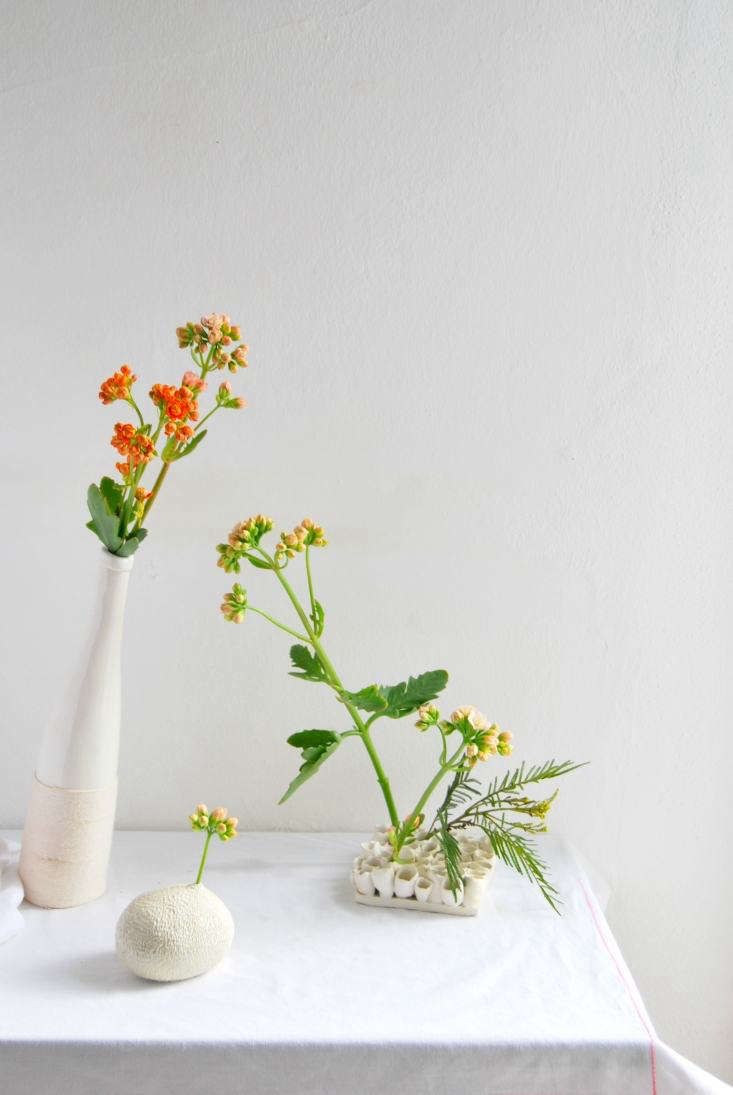Kalanchoe is a common sight at garden centers. With its bright red, yellow, or orange flowers, the blooming succulent is sold as a small greenhouse plant. So I was surprised to see the other day at my local flower market kalanchoes with an entirely different look, with long stems and flowering in gorgeous pastel hues (Millennial pink included).
I couldn’t help but bring some home to arrange in gorgeous vessels by Lisbon-based ceramist Joana Simão. I carefully chose only the flowers that were pale pink and subdued rust colors to use in an arrangement and let them shine on their own, using them as long stems, and minimally, instead of as a filler as they are usually used as a cut flower.
Photography and styling by Chelsea Fuss.

Kalanchoe succulents have a very long vase life (the flowers have been known to last up to four weeks) and offer a long-lasting green leaf along with charming small blossoms. You can even pick the small blossoms off to display in tiny vases as I did here in this oval, textured ceramic vase.

This tiny arrangement adds a sweet touch when displayed in a collection of ceramics as shown, or in addition to a coffee table vignette or bedside table. I’ve displayed two and three stems in the flat, molecular ceramic piece, along with a stem of mimosa greens. A tall bud vase wrapped in string shines brightly with a tall orange kalanchoe blossom.
I love how these modern ceramics elevate kalanchoe, which more often than not is treated more like a grocery store florist’s plant than an accomplice to a chic interior art piece.

Kalanchoe is practical for at-home arrangements because you don’t need a lot to make an impact. Paired with the right vase, just a few stems can make a statement. As I often tell my flower-arranging students, the art of styling flowers is sometimes more about how you edit it and the initial selection of varieties and colors than the actual mechanics of an arrangement.

Pairing the heavy succulent leaves of kalanchoe with a lighter, feathery green such as mimosa adds a contrast to the display, The molecular-style vase works as a flower frog, but by making the mechanics of the arrangement into art.

Kalanchoes don’t need a lot of water, so this vase works nicely with the small ceramic pockets available for water and to steady the leaves.

Sticking to pastel hues makes a calming, restful arrangement for an at-home display; it’s carefree and needs no maintenance.

Here you can see that I cut one stem shorter and left the other taller. In flower arranging, it’s always nice to have a leaf near the rim or bottom of the vase to visually ground the arrangement.

Looking for more about kalanchoes? See our curated guide to Succulents & Cacti 101, especially Succulents Explained: How to Identify and Grow 12 Favorites. Read more:
- Houseplants 101: A Field Guide to Planting, Care & Design
- Succulents: 8 Tips to Help Your Favorite Indoor Plants Survive Winter
- Echeveria 101: A Field Guide to Planting, Care & Design
- Yes, We Can! Bringing Back Grandma’s Violets
- 5 Houseplants that Changed History
- 8 South African Flowers for American Gardens
Finally, get more ideas on how to plant, grow, and care for various houseplants with our Houseplants: A Field Guide.












Have a Question or Comment About This Post?
Join the conversation (2)